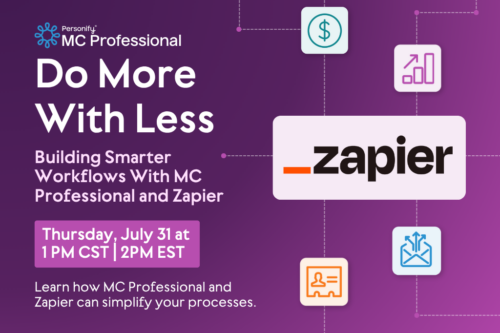Associations give members a place to connect with others with the same interests or in the same field. They also provide members opportunities to further their education and earn valuable certifications within their industry. Organizations that want to approach the learning process in a streamlined way typically invest in association learning management system – or LMS.
Online learning isn’t just for educational institutions. By having an LMS for your organization, you can build your own course content, creating structured and organized learning paths for all your organization needs.
Learning management system
Learning management systems have many different names. They’re also called learning management software or LMS for short.

Learning management systems 101
Whether you already have a bunch of educational materials you want to organize or you want to monetize your learning content, an association LMS can give you the tools you need to optimize the learning process for your members.
In this blog, we’re covering everything you need to know about learning management systems, including:
- What is an association LMS?
- What does an LMS do?
- Can chambers of commerce use an LMS?
- Must-have features to look for
- Having an LMS that connects to your membership management software
- Other resources
LMS for associations: Defined
An association learning management system is a type of software solution that provides the framework for housing and managing all elements of an association’s educational program.
You’ve probably encountered learning management systems before. Any type of organization can use an LMS. Businesses use them to foster ongoing training and education for their employees, and schools use them to manage e-learning.
In the context of associations, learning management platforms are used to create a continuing education plan for their members. It gives associations the ability to provide them with valuable certifications that could further their careers and access new opportunities.
Use cases for an LMS
A learning management system can be adapted and used for all kinds of learning. This is part of what makes it such a valuable tool for membership organizations.
You can use an LMS for:
- Employee training
- Volunteer onboarding
- New-Member Welcome programs
- Certifications
- Committee training
- Board member onboarding
These are just a few ideas! Because you can upload anything from training programs to more formal certification programs, the number of uses of this tool are really unlimited.
What to look for in an LMS
A great LMS for associations will offer a variety powerful features including a dedicated online hub for learning content and the ability for learners to take courses and quizzes online. A learning management software for your association should also have a variety of features that are specific to the needs of membership organizations.
Here’s a rundown of the primary features you should search for when shopping for an association LMS and how you’ll be able to use them.
Content Storage
An ideal LMS will give you a place to store digital learning materials in a content library. Ideally, you will be able to configure your library in various ways to construct individual courses or group content by topic. This feature will allow you to organize all your content, put together courses and structure learning resources in a way that adds value to your members
Responsive Site
LMS should give you the ability to brand your learning management site and personalize it for your own organization. It should also be responsive on any device so that members can use it on their phones, laptops or tablets. This feature allows you to create an aesthetic across your organization between your main website and your learning platform.
Ability to Create Gated Content
Distinguish members-only content from materials that are available to everyone with gated content. Usually, this means you need to be logged in or to have access to the materials in order to view them.
This feature gives you the ability to really personalize your content to your members. It makes the learning programs exclusive which adds value to them. You can also generate non-dues revenue by offering paid content to members and non-members alike.
Assessments and Tests
Testing tools to deliver and score online exams and assess member learning progress are what give your members the change to check their learnings. Another benefit for you is that you’ll know exactly where your members stand and what additional or different learning materials you might want to provide for them to help meet their learning objectives. It can also provide you with insight to if your courses are working the way you want them to.
Certifications
A great LMS will be able to award certificates or documents to celebrate the completion of programs. Look for a software where these are downloadable and/or printable so learners can keep them for their records. Resumes, profiles, LinkedIn accounts or personal use are great ways that these certificates come in handy.
eCommerce Features and Online Payment
An LMS that is based on online learning should provide members an easy way to pay for courses online. Customize payment options and packages to create flexible payment options and meet a wide variety of members’ needs.
Learning management systems for chambers of commerce
LMS platforms can be used by any organization, including chambers of commerce. A chamber of commerce may want to use an LMS for health and safety certifications, resume classes, leadership courses, or business management training.
The great thing about an LMS is that you don’t need to follow traditional learning practises to use it. If you have something you want to teach or share, a learning management system can help.
LMS features to look for
Each LMS system you come across will vary in its features, but these are a few must-have components that you should look for throughout the research process.
1. Great user experience for members and admins alike!
Ideally, your LMS will make it easy for the learner to quickly navigate to their desired content. (And, all of that content should load quickly, too.) Also, make sure your LMS can be designed with your organization’s branding, or similar. You want your learners to be confident that they’re in the right place when they’ve reached your content.
Equally important is the user experience for you, the administrator! A good LMS makes it easy to manage content, learner profiles, certificates, etc. so you can spend more time creating, developing, and delivering that great content.
2. A way to track learners’ efforts
A great LMS will go beyond simply hosting your resources and actually monitor how each individual learner interacts with each piece of content. If continuing education is an important part of your mission and your industry, this is a MUST for your LMS! Look for a solution that allows you to share course outlines, test learners’ knowledge, provide certificates, control permissions on the backend, and, of course, track continuing education units (CEUs).
3. The ability to differentiate between members and non-members
This is key for an LMS solution, for a couple of reasons. For one, separating these two groups means you can offer free content access as a member benefit. More benefits means more member satisfaction, plus another thing to talk to your prospective members about!
That said, offering LMS access as a member benefit also allows you to offer it to non-members for a fee. Hello, new non-dues revenue stream! Managed wisely, an LMS could ultimately pay for itself.
4. Robust content library capabilities
From videos, and MP3s to eBooks and downloadable assets, a great LMS will have a library that works for your needs. It’s likely that you have a few different types of resources. Find an LMS that can host everything – even things you may not have experimented with yet so you know you’re all set for future ideas you have!
You’ll also want to make sure your entire library can be managed easily. Ease-of-use is the make-or-break of an LMS since you, your staff and members should find it fun and intuitive. Being able to create custom content packages, assign content to multiple areas/lessons, and quickly upload content are all things to look for.
5. Superb customer service
As with any software solution, you want an LMS that’s backed by a supportive, knowledgeable, friendly team. When shopping for an LMS, consider asking about how the provider handles onboarding, support, and training needs (if that information isn’t available up front).
Better yet, partner with a company you already know you can trust with MemberClicks by Personify.
6. Flexibility
Finally look for a system that can handle your organization’s unique needs. A software provider will sell you software. A partner will work with you to help you do what you’ve dreamed of, USING their software. Don’t forget the difference.
LMS to AMS integration
As you research LMS options, you’ll find that you can purchase specific systems independently while others are offered in a package along with other association management software (AMS) tools.
Suppose your organization doesn’t yet have an association management software or you’re looking to upgrade. In that case, this could be the perfect opportunity to invest in a membership management solution that includes an LMS.
What Is an AMS?
We have a full guide here, but let’s go over the basics.
An AMS is software that enables membership organizations to manage all membership activities from a centralized, digital platform.
It usually includes:
- A membership database
- An online member community:
- An integrated website content management system (CMS)
- Email and member communications tools
- Data tracking and reporting
- Event management
- Online payment processing and dues collection
Staff benefits of an AMS/LMS Integration
A learning management system can be bought as a stand-alone product, or as tool that integrates with your membership management — or AMS — system.
Some benefits of having an integrated AMS/LMS system include:
- Reduce user friction: An integrated LMS gives your staff members a structured, standardized process for inputting and updating learning modules and materials.
- Save time: Avoid having to manually input or transfer data across multiple platforms. Your integrated LMS blends seamlessly with your larger AMS platform.
- All management solutions within one system: When your LMS is a part of your overarching AMS system, you’ll benefit from having all your information in one place. This makes data tracking and reporting easy.
Member Benefits of an AMS/LMS Integration
Integrating your LMS with your AMS system offers benefits for your members as well. They’ll be able to:
- Access tailored learning opportunities: Using the information in your AMS, such as membership status or past learning history, you can offer personalized learning opportunities to your members.
- Use just one required login: Your members will be able to use just one username and password to access your AMS and LMS instead of having to keep track of multiple logins.
- Navigate the LMS more easily: Using the same system for your AMS and LMS means members will be more familiar with the LMS platform and have an easier time navigating the system.
A Learning Management System Can Change Your Association For Good
From streamlining and automating the learning process to delivering the valuable educational credentials your members desire, your association LMS can provide what your organization needs to offer a comprehensive learning experience. In addition, when your LMS and AMS integrate, you can create a seamless online learning experience for your members and your staff, optimizing the process on both sides.
For more information on learning management systems, check out out blog on 5 Different Ways You Can Use an LMS.
















